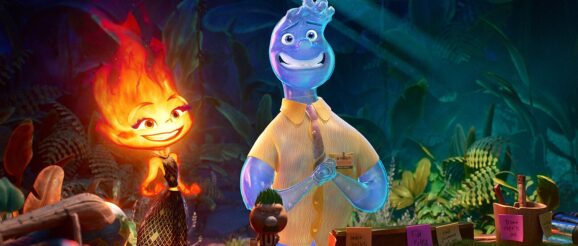Is ‘Elemental’ Another Flop For Pixar Or A Spark Of Innovation? Here’s What The Reviews Say | Digg

Pixar is well known for owning animated movies for the past 30 years. They proved 3D animation could work with “Toy Story” in the mid ’90s, they made you cry with “Wall-E” and “Up” and they’ve won more Oscars than we can count. But lately, they’ve had some critical and commercial flops, and it seems that the Pixar charm/magic has slowly left the studio.
Here is where “Elemental” lies: in between the old Pixar and the new.
“Elemental” is directed by Peter Sohn, and written by four different people (Peter Sohn, John Hoberg, Kat Likkel and Brenda Hsueh). It stars the voice talents of Leah Lewis, Mamoudou Athie, Ronnie del Carmen, Wendi McLendon-Covey, Catherine O’Hara, Joe Pera, Matt Yang King, Jonathan Adams and Wilma Bonet. It releases on June 16, 2023. Here’s what critics have to say.
The premise
“Elemental” is set in Element City, in which communities of people made of air, water, and earth have thrived for generations. But the film, directed by Peter Sohn, is framed partially as a riff on an immigrant story, as we see the first fire people — named Bernie (voiced by Ronnie del Carmen) and Cinder (Shila Ommi) by a well-meaning but confused customs officer — arrive in Element City to make a life for themselves after leaving their home behind. Over time, other fire people join Bernie and Cinder, whose daughter Ember (Leah Lewis) is eventually expected to take over their shop the Fireplace.
At its heart, “Elemental” is a cross-cultural love story, a tale of immigrant tenacity and struggle, and a movie about the challenges of cultural siloing and the responsibilities to respect the sacrifices of those that came before us. All this is heady stuff in what is ostensibly characterized as children’s entertainment, but Pixar films have rarely shied away from more adult, or at least adolescent, concerns. “Elemental” owes much to the likes of “Amélie” with its wide-eyed sense of romance, but also more than a bit of “Guess Who’s Coming to Dinner?” and a dash of “In The Heights” — or even more tragic tales like the Shakespeare-redux “West Side Story,” where differing individuals react strongly to those outside their circle interacting, and star-crossed lovers must overcome the prejudices of those around them.
This is an allegory for immigration
The metaphor here is clear: Plenty of parents pressure their kids to partner up within their race or religion (“Marry Fire!” Ember’s grandmother insists on her deathbed), whereas Sohn wants to show that the alternative needn’t be a bad thing… which every child weaned on American TV and movies has heard a million times already. The message may be obvious, but it’s a little tricky to follow quite how Element City is supposed to correspond to the real world, since there are practical reasons these different characters can’t mix that no amount of rainbows and butterflies can fix.
From the word go, the story of “Elemental” reflects the broad strokes of the American immigrant experience, but it begins to get muddled — slowly at first, and then rather quickly — when it tries to get specific. It pulls details from various real cultures to create its fire community, “the Firish,” born from a mix of minor traditions borrowed from various East Asian, Middle Eastern, and European cultures, and accents that seem to shift between Italian, Hispanic, Iranian, and West Indian at the drop of a hat. The idea may be for immigrant and first generation kids to be able to find some sort of recognition, but the result is del Carmen and Ommi playing an uncomfortable game of ethnic hopscotch with their vocal performances, with practically every line dedicated to some malformed pun unlikely to elicit even chuckle (in Element City, hot dogs are called hot logs, because they’re made of logs).
The animation is impressive
Story aside, there is no doubt that the animators have done a fantastic job when it comes to the animation of “Elemental.” The character design is fittingly adorable and unique. Watching the elements interact and use their elemental abilities to shape the land, specifically Ember’s use of sand to create glass sculptures, is mesmerizing. Scenes where we see Ember and Wade exploring a flooded tunnel or watch as Ember’s flame changes color when she touches mineral rocks are pieces of art, especially when coupled with Newman’s score. In many ways, it’s a pity that the story is not as strong as the animation. The film’s inability to color outside the lines makes a story that is undeniably endearing feel underwhelming, neither unique nor original.
Water has always been a tricky substance for animators, and what Sohn and his team do with it, especially once Ember starts visiting downtown Elemental City with Wade, can be impressive to behold. The wide-ranging color palette includes a gazillion shades of blue, turquoise and green that this partly colorblind critic felt almost assaulted by, and the whole setting looks like Shanghai’s Pudong district dipped into a giant aquarium. Another innovation involves characters whose faces and bodies are filled with constant internal motion, whether swarming with flames or churning with fluids.
But even the film’s promising use of color, form, and movement feels hemmed in by the unimaginative storytelling. Only a few standout sequences — a visit to an underwater garden of Vivisteria flowers, a detour into hand-drawn animation that tells a love story in minimal, swirling lines — separate “Elemental” from any other Pixar film in which the characters are phosphorescent little blobs traveling through realistically animated cityscapes, and as rapidly as the film progresses it never goes anywhere unexpected.
A flawed but big-hearted tale of forbidden love.
